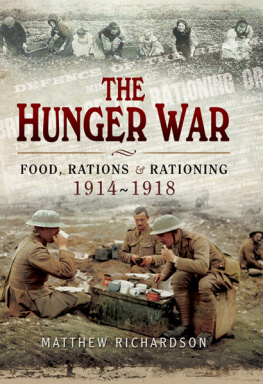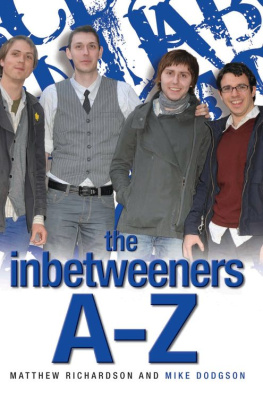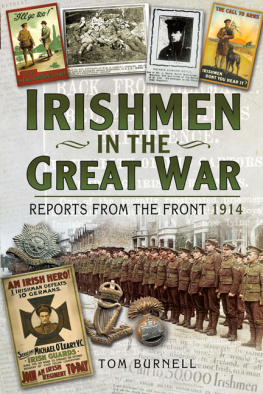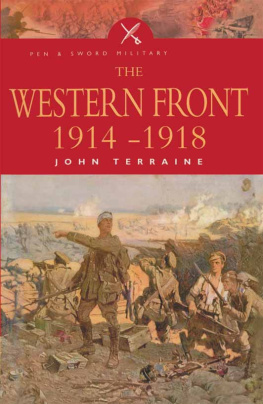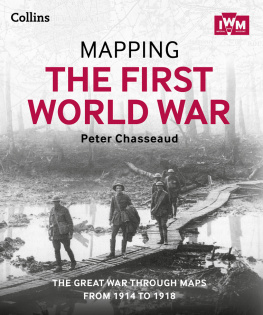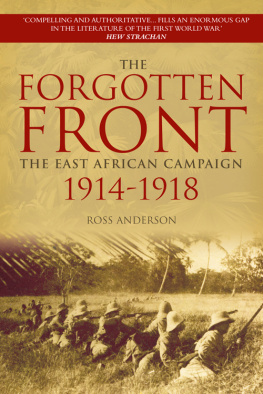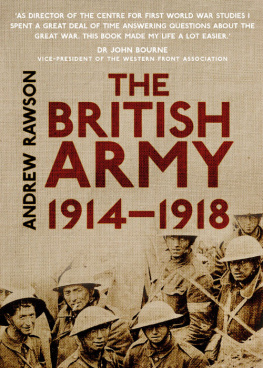Matthew Richardson - The Hunger War: Food, Rations & Rationing 1914-1918
Here you can read online Matthew Richardson - The Hunger War: Food, Rations & Rationing 1914-1918 full text of the book (entire story) in english for free. Download pdf and epub, get meaning, cover and reviews about this ebook. year: 2015, publisher: Pen and Sword, genre: Non-fiction. Description of the work, (preface) as well as reviews are available. Best literature library LitArk.com created for fans of good reading and offers a wide selection of genres:
Romance novel
Science fiction
Adventure
Detective
Science
History
Home and family
Prose
Art
Politics
Computer
Non-fiction
Religion
Business
Children
Humor
Choose a favorite category and find really read worthwhile books. Enjoy immersion in the world of imagination, feel the emotions of the characters or learn something new for yourself, make an fascinating discovery.
- Book:The Hunger War: Food, Rations & Rationing 1914-1918
- Author:
- Publisher:Pen and Sword
- Genre:
- Year:2015
- Rating:3 / 5
- Favourites:Add to favourites
- Your mark:
- 60
- 1
- 2
- 3
- 4
- 5
The Hunger War: Food, Rations & Rationing 1914-1918: summary, description and annotation
We offer to read an annotation, description, summary or preface (depends on what the author of the book "The Hunger War: Food, Rations & Rationing 1914-1918" wrote himself). If you haven't found the necessary information about the book — write in the comments, we will try to find it.
The Hunger War: Food, Rations & Rationing 1914-1918 — read online for free the complete book (whole text) full work
Below is the text of the book, divided by pages. System saving the place of the last page read, allows you to conveniently read the book "The Hunger War: Food, Rations & Rationing 1914-1918" online for free, without having to search again every time where you left off. Put a bookmark, and you can go to the page where you finished reading at any time.
Font size:
Interval:
Bookmark:
First published in Great Britain by
PEN AND SWORD MILITARY
an imprint of
Pen and Sword Books Ltd
47 Church Street
Barnsley
South Yorkshire S70 2AS
Copyright Matthew Richardson, 2015
ISBN: 978 1 47382 749 3
PDF ISBN: 978 1 47387 399 5
EPUB ISBN: 978 1 47387 398 8
PRC ISBN: 978 1 47387 397 1
The right of Matthew Richardson to be identified as the author of this work has been asserted by him in accordance with the Copyright, Designs and Patents Act 1988.
A CIP record for this book is available from the British Library.
All rights reserved. No part of this book may be reproduced or transmitted in any form or by any means, electronic or mechanical including photocopying, recording or by any information storage and retrieval system, without permission from the Publisher in writing.
Printed and bound in England by CPI Group (UK) Ltd, Croydon, CR0 4YY
Typeset in Times by CHIC GRAPHICS
Pen & Sword Books Ltd incorporates the imprints of
Archaeology, Atlas, Aviation, Battleground, Discovery, Family History, History, Maritime, Military, Naval, Politics, Railways, Select, Social History, Transport, True Crime, Claymore Press, Frontline Books, Leo Cooper, Praetorian Press, Remember When, Seaforth Publishing and Wharncliffe.
For a complete list of Pen and Sword titles please contact
Pen and Sword Books Limited
47 Church Street, Barnsley, South Yorkshire, S70 2AS, England
E-mail:
Website: www.pen-and-sword.co.uk
Contents
Acknowledgements
No work of this nature could ever reach print unless the author had received assistance from numerous sources. The book you are about to read is no exception to this rule, and in particular I wish to thank my friend and former colleague Richard Davies at the University of Leeds for his help in relation to the Russian experience of the First World War. Similarly, Christian Greissinger assisted me with German research. Jori Wiegmans in Holland was again immensely helpful in supplying images and other research material, whilst the work of Dr Martin Kraaijestein, and his website Nederland in de Eerste Wereldoorlog, were invaluable to me in helping to understand the Dutch experience of the First World War. I would also like to thank Xining Guo, correspondent for China Central Television Europe, whose translation work proved to be most valuable. Naturally, having paid due acknowledgment to those above, it also goes without saying that any mistakes or misinterpretations within this book are entirely my own responsibility.
Other assistance came from Margaret Holmes and I would like to thank her for her kindness in allowing me to use material relating to her father Frank Richards, likewise Ray Scroby for permission to quote from his fathers unpublished diary. Gillian Lighton sent me extracts from unpublished notes on her family and early life by her mother Margaret Margot Elaine Cliff, which again were immensely useful. My friend and colleague John Caley assisted with a number of illustrations, and for these I thank him warmly.
Rupert Harding at Pen and Sword once again supported my ideas, and offered his encouragement. I thank him for this, and for his assistance over a number of years. To my family once again I extend my apologies, in that the preparation of this book kept me chained to my desk for so many hours, however I hope that in time you may feel that the end result was worthwhile.
Matthew Richardson,
Douglas, 2014
Introduction
The First World War was a total conflict, and food would be one of its major battlegrounds. Blockade tactics had been a feature of warfare for centuries starvation had been used as a weapon at many medieval sieges, and the North had imposed a blockade on the South during the American Civil War. However, what was different about the First World War was the sheer magnitude of the conflict. Victory or defeat would hinge as much upon which side could keep their troops in the field supplied and fed whilst at the same time avoiding starvation on the home front as much as it would upon which side could produce the most shells and guns.
In this conflict, whole societies were at war, and household brands, many of which are still familiar to us today, were mustered to play their part in it. At the same time, the war provided the impetus for and the arena in which some societies attempted to resolve long-running social questions over alcohol and its control. The legacies of some of these experiments are still with us today.
As the war progressed, the ability of the respective combatants to marshal their food resources effectively would become a key component of victory. Those who could not meet this challenge firstly Russia, but eventually also the Ottoman Empire, Austria-Hungary and Germany would fall by the wayside. The Western Allies, by contrast, eventually pooled their food resources, and by forming a bloc were better able to manage what food they had available. These eventual outcomes were not easily discernible or predictable before the war. Germany had spent much time before 1914 preparing a siege economy; the Russian Empire (especially its province of Ukraine) was a vast breadbasket, and Ottoman Turkey was primarily agrarian, whilst on the other hand Britain was heavily reliant upon imported food, and might have been considered to be the state which was most vulnerable to food shortages.
The effects of this total war upon the neutral countries has previously been a neglected and under-researched area, but the impact of the regulations imposed by the Allies and their restrictions upon free trade and the freedom of the seas would have far-reaching consequences for the noncombatant nations also. These consequences, for Denmark, Sweden, Norway, Holland, Switzerland and Spain, are also explored in this book.
Food is a universal constant we all know what hunger feels like, no matter what nationality we are, where we were born or what language we speak. The part played by food and hunger in the First World War deserves closer examination, and this book seeks to chart that role at both national and individual level. Wherever possible it uses eyewitness testimony, and also in a number of cases introduces the modern reader to some now almost forgotten writers, whose work is surely worthy of reexamination.
Chapter 1
On the Battlefronts: The Western Front
During the First World War, feeding soldiers in the front line became a major logistical challenge. Ensuring an adequate and palatable food supply to the troops was crucial not only to their health, but also to their morale. At times, due to battle, this supply became haphazard; the British also faced the challenge of feeding South Asian troops with special dietary requirements, and POWs often faced particular food hardships, but on the whole soldiers of both sides were inventive, and inveterate, scroungers. Tinned products were a central part of the soldiers diet: sometimes these were monotonous, but they were often supplemented by supplies from family at home. This chapter examines the differences in food supplies between officers and men, and between differing armies, on the Western Front as the First World War progressed.
Prior to the war a considerable amount of scientific work had been carried out to establish what was the optimum daily calorie intake for a front-line soldier, and each combatant nation had based its daily ration for the ordinary fighting man upon what it believed this quantity of food to be. When they entered the war in 1917, soldiers of the United States were the best fed, with a daily quota of 4,714 calories. Next were the French with a quota of 4,466 calories, then the British with 4,193 calories and finally the Germans with 4,038. Of course, these figures were only ever an ideal, because everything depended upon the food being able to reach the soldier, and at times this simply was not possible. Things also changed during the course of the war; as the conflict went on and shortages began to bite, official rations were reduced. In June 1916 the meat portion of the German soldiers ration was cut, and in April 1917 his bread portion followed suit. By the opposite token, under certain circumstances soldiers found themselves able to supplement their rations, either by buying or taking food from civilians.
Next pageFont size:
Interval:
Bookmark:
Similar books «The Hunger War: Food, Rations & Rationing 1914-1918»
Look at similar books to The Hunger War: Food, Rations & Rationing 1914-1918. We have selected literature similar in name and meaning in the hope of providing readers with more options to find new, interesting, not yet read works.
Discussion, reviews of the book The Hunger War: Food, Rations & Rationing 1914-1918 and just readers' own opinions. Leave your comments, write what you think about the work, its meaning or the main characters. Specify what exactly you liked and what you didn't like, and why you think so.

